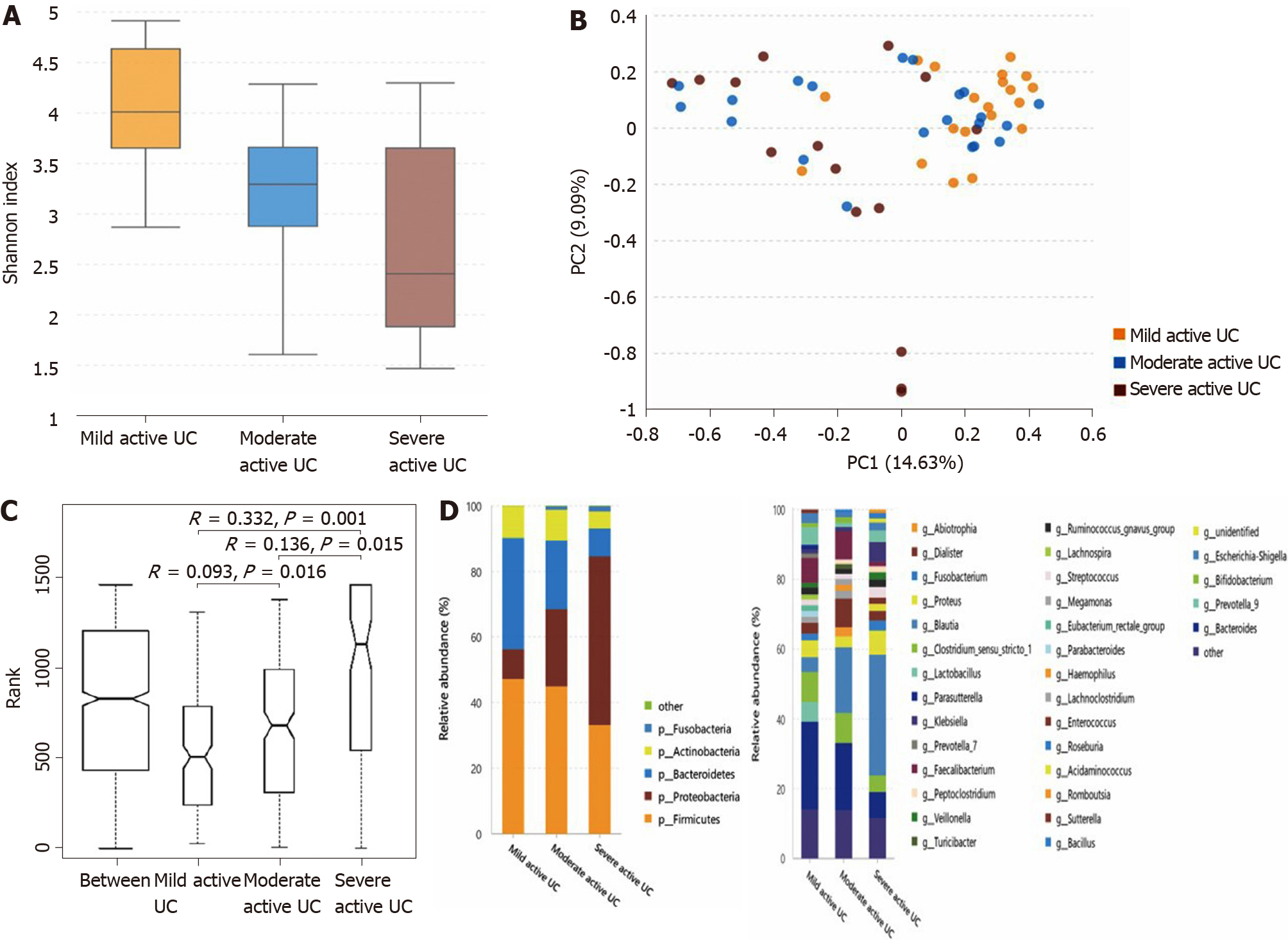Copyright
©The Author(s) 2021.
World J Gastroenterol. Jul 28, 2021; 27(28): 4722-4737
Published online Jul 28, 2021. doi: 10.3748/wjg.v27.i28.4722
Published online Jul 28, 2021. doi: 10.3748/wjg.v27.i28.4722
Figure 3 Statistical analysis of the sequencing results of the bacteria microbiota in stool samples from mild, moderate, and severe active ulcerative colitis groups.
A: The α-diversity of microbiota evaluated by Shannon index. The ordinate shows the Shannon index, and the abscissa shows the groups. The α-diversity of the intestinal microbiota gradually decreased along with increasing inflammation degree (the Shannon index of mild, moderate, and severe active ulcerative colitis (UC) was 3.74 ± 0.84, 3.08 ± 0.95, and 2.66 ± 1.14, respectively), and the difference between the mild and moderate groups (P = 0.025), and between the mild and severe groups (P = 0.003) was significant, although that between it was not significantly between the moderate and severe groups (P = 0.235); B: Principal component analysis. The flora structure of mild, moderate, and severe active UC groups showed an obvious difference (with a PC1 of 14.63% and a PC2 of 9.09%, as showed in the abscissa and ordinate axis separately); C: The analysis of similarities. The intergroup differences between any two of these groups were significant (P = 0.016 between the mild and the moderate stage group, P = 0.015 between the moderate and the severe stage group, and P = 0.001 between the mild and the severe stage group); D: The relative abundance of the bacteria at the phylum (the left bar graph) and genus (the right bar graph) levels. The ordinate shows the relative abundance (%), and the abscissa axis shows the sample types where the microbiota was sequenced from. At the phylum level, the abundance of Proteobacteria showed a significant trend of increase with a deteriorating disease condition, and that of Bacteroidetes gradually decreased, though only the difference between mild and severe subgroups was obvious. At the genus level, some bacteria genera that differed significantly between non-inflammatory bowel disease (IBD) controls and active patients with UC displayed a consistent changing pattern when the disease condition was getting worse, including a further increase of Escherichia-Shigella in moderate-severe active UC and an obvious reduction of Faecalibacterium, Roseburia, and Bacteroides in severe active UC. The relative abundance of Eubacterium rectale group gradually decreased when the inflammation worsened though this genus did not differ significantly between non-IBD controls and patients with UC. Decreased Blautia in moderate active UC and reduced Parasutterella and Lachnospira in severe active UC compared with the mild group were also observed. UC: Ulcerative colitis.
- Citation: He XX, Li YH, Yan PG, Meng XC, Chen CY, Li KM, Li JN. Relationship between clinical features and intestinal microbiota in Chinese patients with ulcerative colitis. World J Gastroenterol 2021; 27(28): 4722-4737
- URL: https://www.wjgnet.com/1007-9327/full/v27/i28/4722.htm
- DOI: https://dx.doi.org/10.3748/wjg.v27.i28.4722









